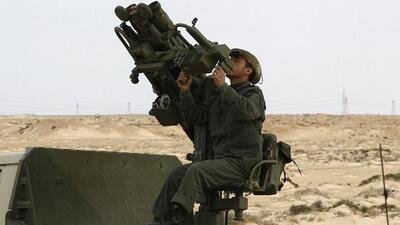
The Pentagon confirmed Friday it has redirected a carrier strike group from the Mediterranean to the Southern Command (SOUTHCOM) are of operations to join the significant amount of warships already patrolling waters of Venezuela’s coast.
Published October 26, 2025

The Igla-S is a Russian-made, shoulder-fired surface-to-air missile system designed to target low-flying aircraft using a dual-band infrared seeker that resists flares and decoys (Picture Source: Venezuelan MoD)
 Implications
Implications
The deployment of up to 5,000 Russian-made Igla-S MANPADS across Venezuela carries strategic, regional, and operational implications that extend far beyond the country’s borders. While President Nicolás Maduro frames the move as a purely defensive measure, the scale and positioning of these systems introduce new calculations for regional militaries and U.S. operations in the Caribbean.
1. Regional Deterrence and Escalation Risks
Venezuela’s bolstered air-defense grid represents a visible deterrent aimed at discouraging U.S. and allied reconnaissance flights near its territory. However, such saturation of short-range missile systems also raises the likelihood of misidentification or accidental engagement. Low-flying patrol or humanitarian aircraft operating near disputed airspace could become targets in a high-tension scenario, especially if command and control are decentralized.
2. Complicating U.S. and Allied Operations
For the United States, the deployment complicates both intelligence-gathering and contingency planning in the Caribbean basin. Low-altitude flights—used for radar mapping, maritime patrol, or surveillance—would face greater risks from dispersed, mobile launchers. This could force higher flight altitudes, reducing sensor effectiveness and increasing fuel costs. U.S. Southern Command may need to rely more heavily on stand-off assets, satellites, and naval drones to monitor Venezuelan movements.
3. Strengthening Venezuela’s Internal Control
Domestically, the extensive MANPADS distribution may reinforce Maduro’s hold over the military, ensuring loyalty among regional commands tasked with operating and guarding these systems. Yet, it also raises concerns about accountability and proliferation. The Igla-S is compact, easy to conceal, and potentially dangerous if diverted to non-state actors or paramilitary groups—a risk that alarms Western intelligence agencies.
4. Signal to Moscow and Beijing
The integration of Russian and Swedish systems highlights Caracas’s strategy of defense diversification. Moscow benefits from the optics of a close ally showcasing Russian hardware in defiance of U.S. sanctions, while Beijing may view Venezuela’s defense modernization as a test case for asymmetric deterrence strategies in the Western Hemisphere. Both capitals interpret the deployment as a reminder that U.S. influence in Latin America is no longer uncontested.
5. Impact on Caribbean Stability
Neighboring countries such as Colombia, Guyana, and island states aligned with Washington may reassess their airspace management and radar coordination. The presence of thousands of MANPADS within reach of regional flight corridors introduces new risks for civilian aviation, particularly if the systems are dispersed without tight central oversight. The Organization of American States (OAS) could face renewed debate on arms transparency and regional de-escalation protocols.
6. Shift Toward Denial, Not Dominance
Ultimately, Venezuela’s move signals a shift toward “denial-based defense”—aiming to make foreign intervention or overflight prohibitively risky rather than achieving total control of its skies. The saturation of MANPADS and short-range defenses turns Venezuela into a complex, high-risk environment for any potential aggressor, a strategy reminiscent of Cold War-era tactics used by smaller states aligned with major powers.
 Overall Takeaway:
Overall Takeaway:
Venezuela’s nationwide deployment of Igla-S MANPADS is more than a show of strength—it is a calculated move in a broader strategy of deterrence and denial. By integrating shoulder-fired missiles into a multi-layered air-defense network, Caracas is attempting to compensate for its limited conventional air power with a dense, mobile, and unpredictable defensive grid. The message is clear: any low-altitude operation near Venezuelan airspace will now carry serious risks.
While the true number of deployed systems remains uncertain, the political and psychological impact of Maduro’s announcement is undeniable. It projects resilience against perceived U.S. encroachment and reaffirms Venezuela’s partnership with Moscow. Yet the same move introduces new dangers—chief among them the risks of proliferation, miscalculation, or accidental engagement in a region already strained by overlapping security interests.
In the end, Venezuela’s focus on MANPADS marks a shift toward asymmetric defense: trading high-cost weapons for widespread coverage that complicates enemy planning. Whether this buildup strengthens national sovereignty or deepens regional instability will depend on how responsibly Caracas manages and controls its growing arsenal. What’s certain is that the Caribbean’s security environment has entered a more volatile phase—one where deterrence, perception, and restraint will define the balance between peace and provocation.
SOURCES: ARMY RECOGNITION – Venezuela Declares 5,000 Igla-S Missiles in Nationwide Defense Net to Deter U.S. Caribbean Flights.
ZEROHEDGE – Maduro Boasts He’s Moved Thousands Of Russian Anti-Air Missiles To Venezuela’s Coast





Be the first to comment